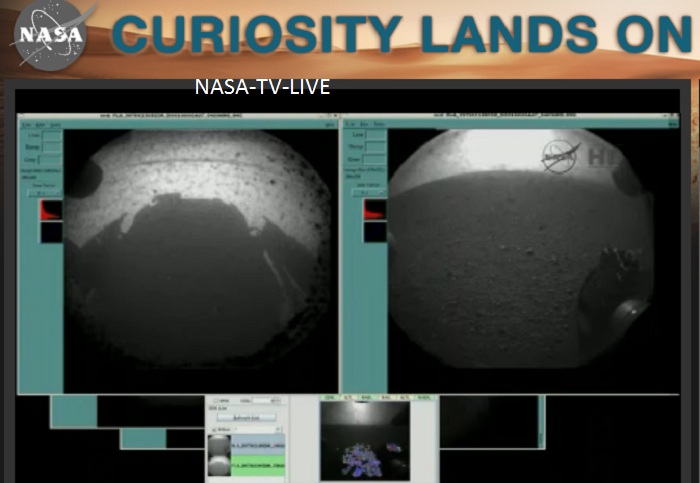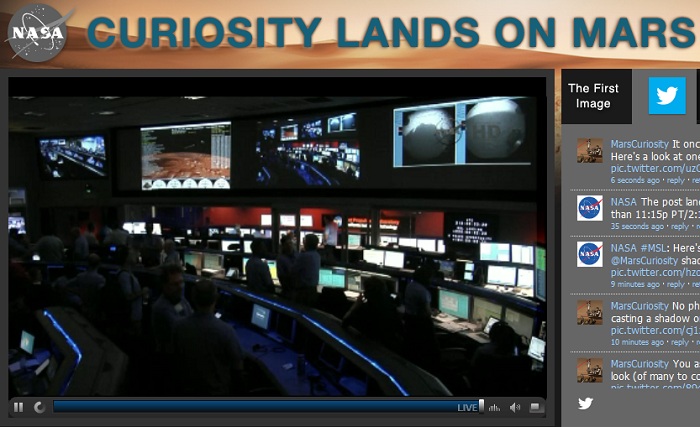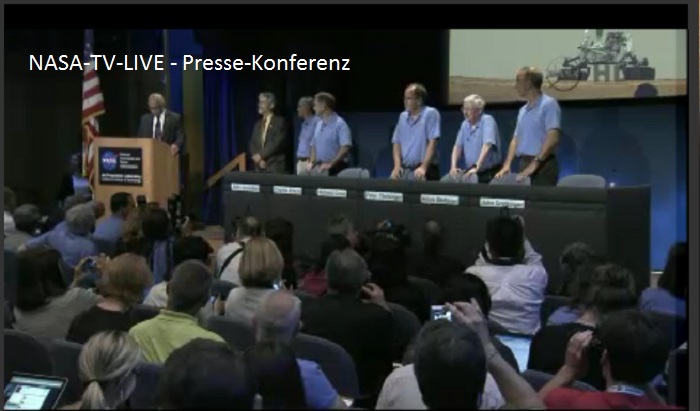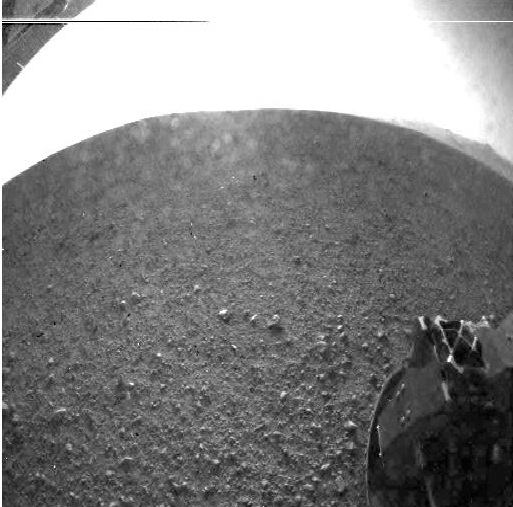Fotos: NASA-TV
-

News of the 1-ton Curiosity rover's successful landing came in at 10:31 p.m. PDT Sunday (1:31 a.m. EDT and 0517 GMT Monday), though the robot actually touched down inside Mars' huge Gale Crater around 10:17 p.m. (It takes about 14 minutes for signals to travel from the Red Planet to Earth).
-



Update: 6.08.2012 / 9.25 MESZ
Statement by the President on Curiosity Landing on Mars
Tonight, on the planet Mars, the United States of America made history.
The successful landing of Curiosity – the most sophisticated roving laboratory ever to land on another planet – marks an unprecedented feat of technology that will stand as a point of national pride far into the future. It proves that even the longest of odds are no match for our unique blend of ingenuity and determination.
Tonight’s success, delivered by NASA, parallels our major steps forward towards a vision for a new partnership with American companies to send American astronauts into space on American spacecraft. That partnership will save taxpayer dollars while allowing NASA to do what it has always done best – push the very boundaries of human knowledge. And tonight’s success reminds us that our preeminence – not just in space, but here on Earth – depends on continuing to invest wisely in the innovation, technology, and basic research that has always made our economy the envy of the world.
I congratulate and thank all the men and women of NASA who made this remarkable accomplishment a reality – and I eagerly await what Curiosity has yet to discover.
Update: 6.08.2012 / 12.30 MESZ

This is one of the first images taken by NASA's Curiosity rover, which landed on Mars the evening of Aug. 5 PDT (morning of Aug. 6 EDT). Image credit: NASA/JPL-Caltech

PASADENA, Calif. - About two hours after landing on Mars and beaming back its first image, NASA's Curiosity rover transmitted a higher-resolution image of its new Martian home, Gale Crater. Mission Control at NASA's Jet Propulsion Laboratory in Pasadena, Calif., received the image, taken by one of the vehicle's lower-fidelity, black-and-white Hazard Avoidance Cameras - or Hazcams.
The black-and-white, 512 by 512 pixel image, taken by Curiosity's rear-left Hazcam,
"Curiosity's landing site is beginning to come into focus," said John Grotzinger, project manager of NASA's Mars Science Laboratory mission, at the California Institute of Technology in Pasadena. "In the image, we are looking to the northwest. What you see on the horizon is the rim of Gale Crater. In the foreground, you can see a gravel field. The question is, where does this gravel come from? It is the first of what will be many scientific questions to come from our new home on Mars."
While the image is twice as big in pixel size as the first images beamed down from the rover, they are only half the size of full-resolution Hazcam images. During future mission operations, these images will be used by the mission's navigators and rover drivers to help plan the vehicle's next drive. Other cameras aboard Curiosity, with color capability and much higher resolution, are expected to be sent back to Earth over the next several days.
Curiosity landed at 10:32 p.m. Aug. 5, PDT, (1:32 a.m. EDT, Aug. 6) near the foot of a mountain three miles (about five kilometers) tall inside Gale Crater, 96 miles (nearly 155 kilometers) 7in diameter. During a nearly two-year prime mission, the rover will investigate whether the region has ever offered conditions favorable for microbial life, including the chemical ingredients for life.
The mission is managed by JPL for NASA's Science Mission Directorate in Washington. The rover was designed, developed and assembled at JPL, a division of Caltech.
Update: 6.08.2012 / 16,30 MESZ
ESA spacecraft records crucial NASA signals from Mars
This morning at 7:14 CEST, ESA’s Mars Express acquired signals from NASA’s Mars Science Laboratory as it delivered the car-sized Curiosity rover onto the Red planet’s surface. ESA’s New Norcia tracking station also picked up signals directly from the NASA mission, 248 million km away at Mars.
A key step was completed today in ESA's ongoing support to NASA's Mars Science Laboratory (MSL) mission. Signals recorded by Mars Express during MSL’s entry and descent were successfully received at ESOC, ESA's European Space Operations Centre, Darmstadt, Germany.
The open-loop recording of radio Doppler and signal spectrum transmitted by the NASA mission were stored on Mars Express and then downloaded to Earth starting at 08:15 CEST.
The recorded signals were transferred to NASA’s Jet Propulsion Laboratory, Pasadena, California, for analysis immediately upon receipt at ESOC. Similar direct-to-Earth recordings made at ESA’s New Norcia ground station in Australia were also sent to NASA.
Curiosity’s descent was also tracked by NASA’s own Odyssey and Mars Reconnaissance Orbiter (MRO) spacecraft; confirmation of touchdown was provided by Odyssey directly to NASA at 07:31 CEST.
ESA welcomes new friend at Mars
"Congratulations to our NASA colleagues on a hugely successful landing,” said Paolo Ferri, ESA’s Head of Solar and Planetary Mission Operations. “The Mars Express team welcomes a new friend in the neighbourhood."
Mars Express picked up MSL signals about 10 minutes before it entered the atmosphere, travelling at 21 000 km/h, for its critical descent and landing phase.
“We tracked MSL for about 28 minutes then lost contact as expected just a few moments before Curiosity’s touchdown in Gale Crater,” said Michel Denis, Mars Express Spacecraft Operations Manager.
“NASA now have this valuable data and everyone here is delighted to have helped support Curiosity’s arrival at Mars.”
The signal recordings made by Mars Express and New Norcia station include information on MSL’s velocity and direction. They record the sequential critical events during descent, including parachute deployment, heat shield separation and rover separation.
They will prove valuable to scientists as they reconstruct MSL’s descent profile, helping to improve and refine models of the martian atmosphere and assess landing accuracy.
The signals recorded by Mars Express will be automatically downloaded two more times later today via New Norcia and ESA’s Cebreros station, in Spain, to ensure redundancy.
ESA’s first step in continuing Curiosity support
In the coming weeks, Mars Express and the operations team at ESOC will perform several data relay overflights during the first phases of Curiosity’s mission on the surface of Mars.
Then, ESA will offer a standby capability to provide dedicated support at short notice, if requested by NASA, by relaying data from Curiosity to Earth.
This could become necessary if Odyssey or MRO were to experience any technical problems, for example.
ESA’s tracking station network can support NASA missions, due in part to long-standing technical and operational cooperation between the two agencies.
“Supporting Curiosity is an excellent example of inter-agency cooperation not only on Earth but also in deep space,” said Manfred Warhaut, ESA’s Head of Mission Operations.
“No one likes going to Mars on their own; it takes cooperation and partnership to reduce risk and boost scientific return on investment.”
Quelle: ESA
Update: 6.08.2012 /22.00 MESZ
-

